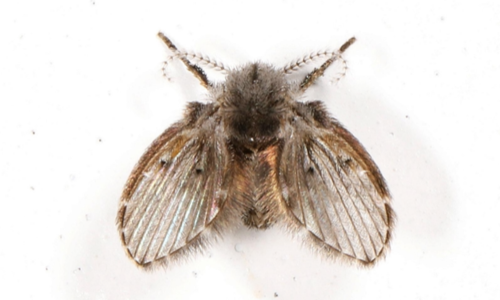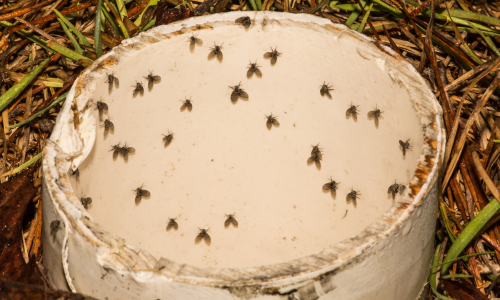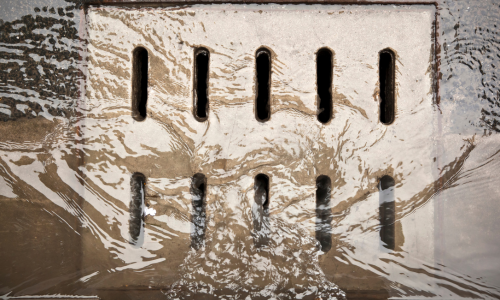Updated on March 26th, 2025
I’d rather not hear a story of the multitude of squirming little wrigglers you happened upon while washing your dishes. I’d rather not know the fact that these worm-like insects hatch within two days of being laid. I’d rather there were no drain flies at all.
But there are.
Let's figure out what to do about them.
In this guide, we’ll explain what they are, whether drain flies are harmful and how to remove drain flies from your home for good.
What are drain flies?

Drain flies are also known as sewer flies. Other commonly known names are sink flies, filter flies and sewer gnats. This fly belongs to the family of true flies known as psychodidae. Some drain flies, like the moth fly, have short, hairy bodies and wings that give them a soft, velvety moth-like appearance. We’ll focus on these soft, cute ones.
Note: When identifying what your tiny black flying invader is, ensure that it is not a gnat or fruit fly.
Sewer flies are small, measuring between 2-5 millimeters in length. That range is anywhere from the point of a new crayon (2 millimeters) to a pencil's eraser top (5 millimeters). Like all flies in the order Diptera, they have a single pair of wings, compound eyes and mouthparts that are designed for sucking and piercing. These pale gray to black colored flies have small round hairy wings that are held pitch-roof-like over their roundish fuzzy bodies. They may remind you of moths, as they’ve got similar looks and behavior (fairly harmless and peaceful).
Despite their mothlike appearance, sewer flies are not particularly adept at flying long distances. They're actually quite unstable and unpredictable in the air. Rather than attempting a good flight, they focus on what they’re good at—hopping. They jump around as they feast on bacteria, gorging themselves on these single-celled organisms (which exist everywhere).
Finding a business of flies or their babies (larvae) in your sink drain is not pleasant. It’s actually downright horrid. These tiny revolting creatures feed on that slimy, mucky still bacteria that can, if not dealt with on a regular basis, develop along the water surface of your infrequently used toilet bowl or other prime breeding grounds. This muck is also their breeding ground, where they lay some 30-100 eggs, which hatch in about two days.

To further disgust you—and my sincere apologies as even my stomach is beginning to feel queasy—the nearly transparent worm-like larvae can sometimes be seen moving along the moist edges or crevices of your shower stall or crawling along the bathtub wall. When I lived overseas, cockroaches would try to get into our bathtub through the drain (in the tub). Their dark little antenna would poke out, moving this way and that, and be so very close to my two big toes. Creepy crawlies are the worst when you’re trying to soap off and then, seeing one, your mind becomes filled with filth and dirt and you want to bathe all over again (in a different location, in a different country perhaps).
Now, back to their larvae. Their larvae have a non-retractable black head, are usually between 4-5 mm in length (think pencil eraser top) and are shaped like long, thin, somewhat flattened cylinders. They can, in small numbers, be beneficial, as their strong jaws can cut through hair and sludge waste that can accumulate and cause clogs in your drain. This beneficial number, mind you, does not last long, as the flies, as long as the sludge layer remains, will lay more and more eggs.
What causes drain flies?
Drain flies, like many miscreants, seem to appear out of thin air. All homes, though, have tiny holes. It’s not uncommon for these fuzzy winged invaders to enter your home through extremely small holes. Even if you promptly close all doors upon entering and exiting them and make sure all windows are always latched tight, they can still find a way.
They’re much more likely to say "yes" to your piece of real estate if you have stagnant water. Standing water collects bacteria, or nutrient-laden organic material, which is what these little hopping intruders are after.
They will merrily congregate at these locations:
- Fixture drains—toilet and sink
- Floor drains—bathtub and showers
- Septic tanks
- Sewers
- Soil that contains sewage
Can drain flies make me ill?
Are drain flies harmful? Fortunately, they don’t bite, sting, nip, pinch or nibble. They don't carry any pathogens that cause human disease. Heavy infestations may exaggerate asthma symptoms in some people, as the dried parts of dead flies float through the air, but that would have to be a very substantial infestation. Their larvae have been known to be an opportunistic agent of myiasis—a parasitic infection of the body that can occur when the larvae enter the body—though this is quite rare. So, no, drain flies aren’t likely to make you sick.
How do I get rid of drain flies?

Once you’ve properly identified these tiny black invaders, it’s time to get rid of drain flies by thoroughly cleaning your drains. Use a long-handled stiff-bristled brush to scrub in and around your home’s fixture drains and floor drains to remove any accumulated scum. As you do so, carefully pour hot water down the drain. Continue pouring hot water down the drains every one to two days for a week, as drain flies can be difficult to drown as they can trap air bubbles and remain submerged for a day or more.
If you’re wondering how to remove drain flies completely, I recommend pairing the scrub/hot water get-rid-of-drain-flies strategy with a natural cleaning solution, as this will sterilize your drains and reach more areas than just the boiling water. Bonus: You’ll probably already have these go-to ingredients in your pantry—and here’s exactly how to use them.
Directions
- Mix one-half cup salt with one-half cup baking soda. Pour this solution into the drain.
- Fill a container with one cup of white vinegar. Pour into the drain. (As the vinegar mixes with the baking soda, it will bubble and foam.)
- Allow this to sit as long as you are able, ideally for at least 12 hours.
- Pour hot water down the drain to swirl away any remaining fly larvae.
If you see a drain fly hopping nimbly around your drain, give it a quick shot of our Six Feet Under Plant-Powered Insect Spray, a non-toxic kill-on-contact spray powered by a handcrafted blend of clove, cinnamon and soybean oils. This is a superb drain fly killer.

I also recommend our Insect Buster filled with Dust to Dust Plant-Powered Insect Powder. For adult drain flies resting near sinks, tubs or garbage disposals, a few puffs of Dust to Dust in dry surrounding areas (like baseboards or corners near drains) can create a lethal landing zone. Once they walk through it, this plant-powered powder begins to work its magic. Bye bye flies.
Note: Dust to Dust is a safer and more effective alternative to diatomaceous earth for insect control, with proven kill times up to 50% faster. Avoid applying Dust to Dust directly inside active drains or anywhere it might be rinsed away. For best results, use it in dry zones where adult flies tend to rest or hover.
Our final recommendation: The Fly Inn is designed to give flies a permanent vacation. Use The Fly Inn's suction cups to attach the trap to your window and catch drain and sewer flies with ease.
Final word on drain flies
It’s interesting how an insect can be both disgusting and beneficial, and how we can work so hard to keep them out of our homes, only to find them appear again - whether it be a spider, a ladybug or one of many species of flies. Have you dealt with sewer flies? Were you able to end the invasion quickly? Do share your experience by contacting our team today.





















